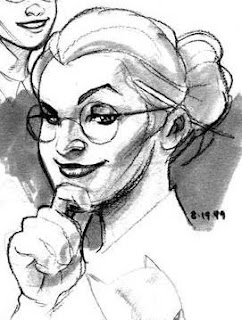
I've only recently realized that with pretty much everything I do that's creative, I start small/basic and work my way up to larger/detailed. I've been doing this for years, but it's only because I explain my processes on this blog that I saw the obvious.
Yet another example of this principle is the thumbnail. I don't know why they are called this. A thumbnail is a small--and in some cases very small--sketch of the composition rooted down to its most basic shapes. I've done them as small as an inch tall before, rolling through tons of ideas until I start getting something I like. Lots of beginning artists like to go right into the detail work when they start a drawing. I know I did when I first started learning. The cool details are very enticing and a lot of fun, but you can't start laying bricks without an architectural plan. As I grew as an artist, I learned that doing these basic rough sketches can be just as fun and educational as the detail work.
This example is a rather large thumbnail measuring 3x6 inches. I did it large because I already had an idea that I liked, and I wanted to get moving on this project. Also, I did a few smaller ones in my sketchbook I leave in my locker at work. So there. I usually have blocked out everything in pencil at this stage, and make mental notes of where shadows go. But, in my experience, it's always better when I grab a sharpie or brush-pen and start drawing in shadows as large shapes.


















































